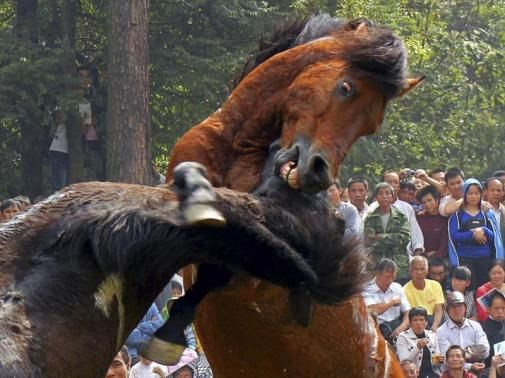Battling Stallions: China’s Miao Ethnic Group Celebrate New Year With Medieval-Era Horse Fights

As China and the global Chinese diaspora recently celebrated the Year of the Horse, some Chinese in the southern part of the country ushered in the New Year with a practice that many around the world might find barbaric and cruel. In mountain villages across southern China, spectators watched a 500-year-old tradition that pits two stallions fighting each other over mares in a public arena before hundreds of cheering, jeering, excited people Agence France Press (AFP) reported that in the remote village of Tiantou in the Guangxi province, local residents cheered wildly as they watched two large male horses battle each other violently, featuring frenetic kicking, biting, snorting and neighing, and much blood. (The mare is kept nearby as a form of enticement for the sexually charged combatants.)
AFP noted that there were no barriers separating the human onlookers from the battling equines. "Without horse-fighting it wouldn't feel like a New Year," Pan Jianming, owner of a winning stallion, told AFP. "He stood up and hit the other horse straightaway. If he likes the female horse, it doesn't matter how much pain he's in, he won't run away. We have medicine to treat his injuries, and he will gradually get better.” Such competitions are held around the year but intensify during New Year celebrations. “We used to hold horse fights just once a year, but now we do it more often. Because this is the Year of the Horse, we are even more happy,” said Zhou Tingyi, who supervised the fights in Tiantou. “You need a good horse for fighting, it needs to be fat, it needs to have more energy.”
Pan won 500 yuan (about $82) as a prize for his winning horse in a tournament that featured 15 animals in competitive bouts. “Horse-fighting is just for fun,” Pan added. “If I win, people will think of me as a horse king, and it’s also good for attracting women.”
Horse-fighting is part of the ancient tradition of the Miao ethnic group that has survived into the 21st century, but the practice has been condemned by animal welfare groups. Animals Asia Foundation, a Hong Kong-based rights campaigner, blasted horse fights as a "horrific spectacle" and labeled it as a promotion of "abuse and suffering [of] animals in the name of entertainment.” "It is nothing but barbaric," said Vivian Farrell, president of the International Fund For Horses, a group that has led efforts to ban horse fighting, to the Daily Mail. "It’s cruel and inhumane and I don’t know why they do it. First of all, they get a mare in season to arouse the stallions, then they take the mare away and the fighting begins. They will rear at each other and kick and bite in the bid to show whose bloodline is superior.” Farrell added: "Sometimes the fights last 10 minutes -- sometimes they go on for half an hour. It’s not normally a fight to the death, but occasionally animals have to be put down."
As pet ownership has increased across Chinese urban centers, so have concerns about animal safety within the country itself. "It's horrible to see the horses get injured. I don't like to watch," said 14-year-old tourist Ma Jiasui, who witnessed the fight, while curiously adding, "It's the Year of the Horse, and my surname means horse, so it's special to see horse fighting this year."
But most people in the Miao village defended the custom, insisting it did not amount to animal cruelty. "Sometimes the horses will be injured but it won't be very serious, they have thick skin," said a young spectator named Di Zhai. Numbering almost 9 million people, the ethnic Miao are one of the largest minority groups in southwest China.
A group called Save The World’s Horses noted on a blog that horse-fighting is also practiced in Indonesia, South Korea and in Mindanao in the southern Philippines. “These tournaments are truly barbaric.” said Andrew Plumbly of the Network for Animals welfare group. “Our [observers] have seen horses being kicked in the head so hard that their eyes have popped out of their sockets. Other horses have had their ears ripped off. It’s straight out of the Middle Ages.” An official from People for the Ethical Treatment of Animals (PETA) lamented that children watch these battles. “One of the most disturbing things about these images is the crowd of sadists (and children who are too young to know any better) who look on and smile — as if they were at a football game rather than a ritual torture,” PETA said.
© Copyright IBTimes 2024. All rights reserved.





















